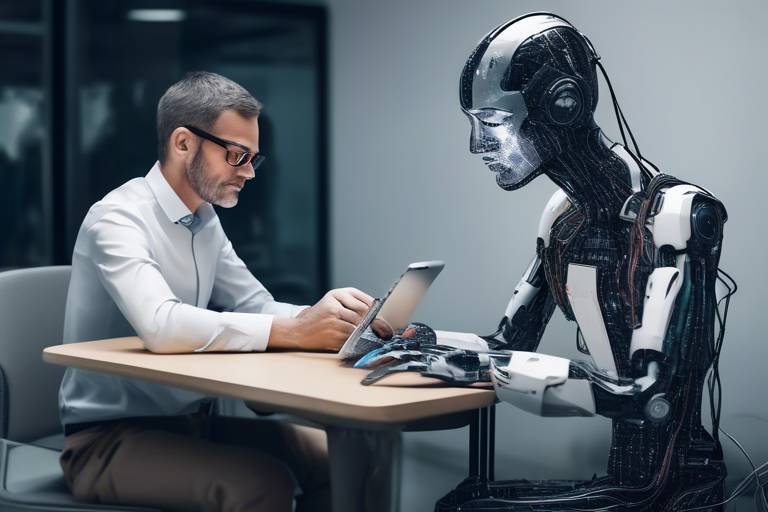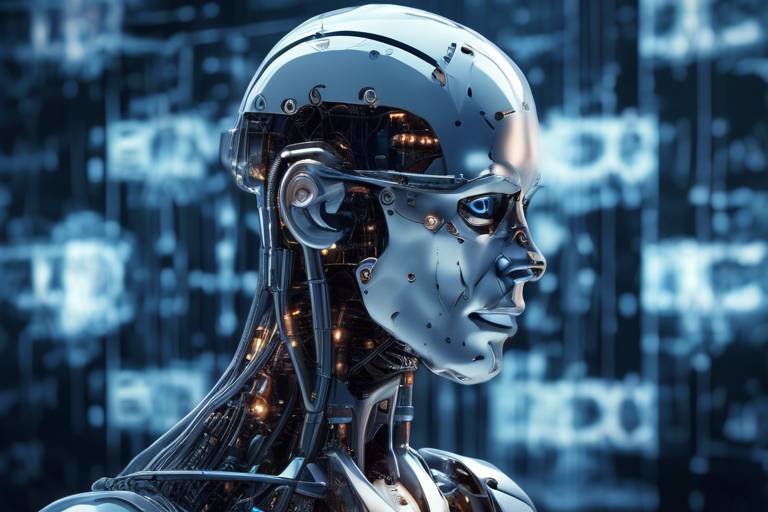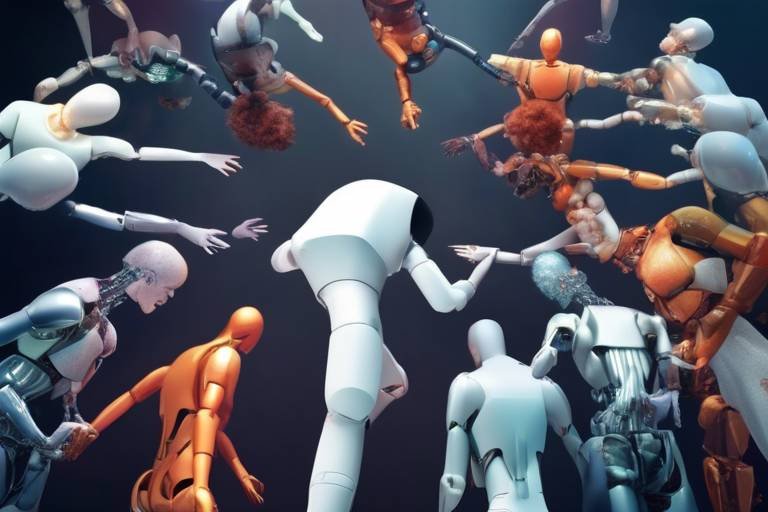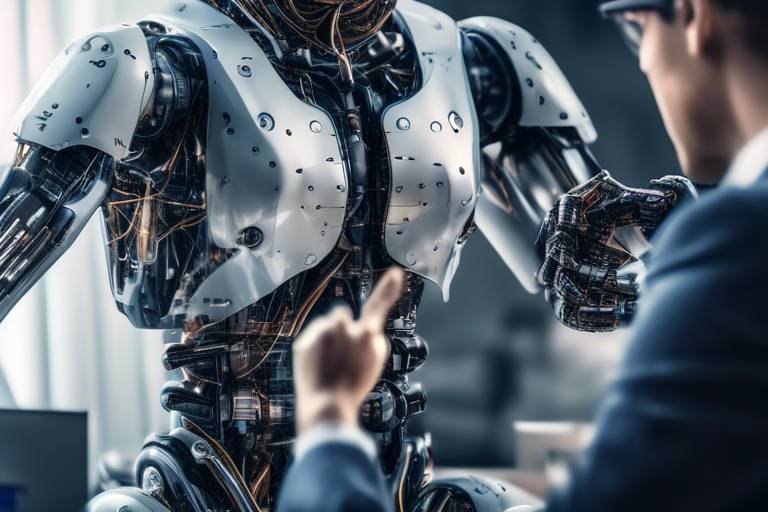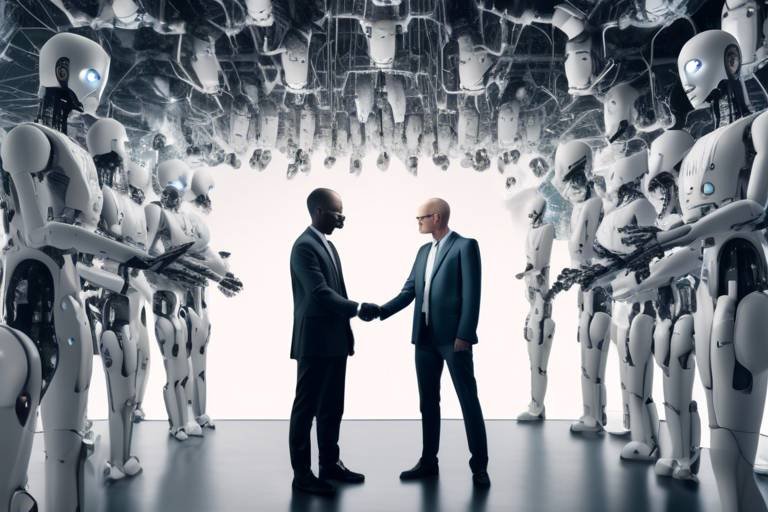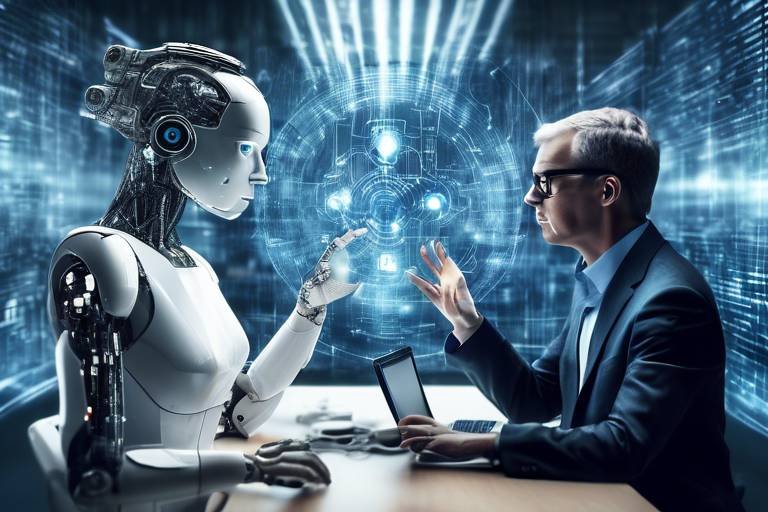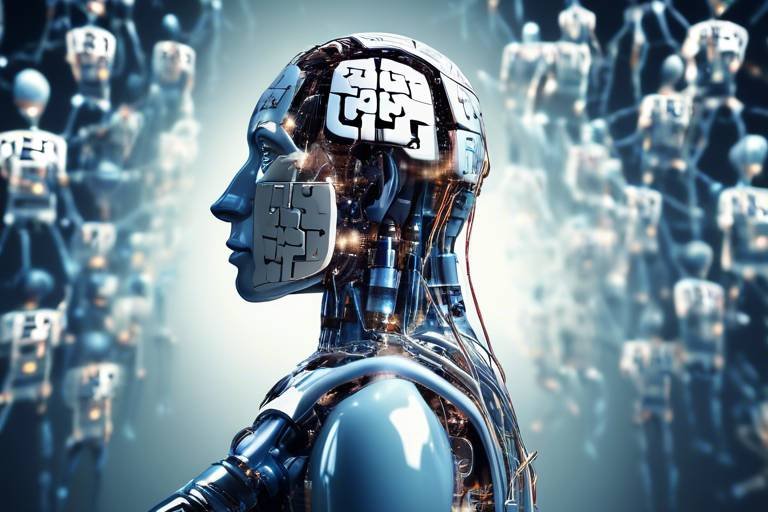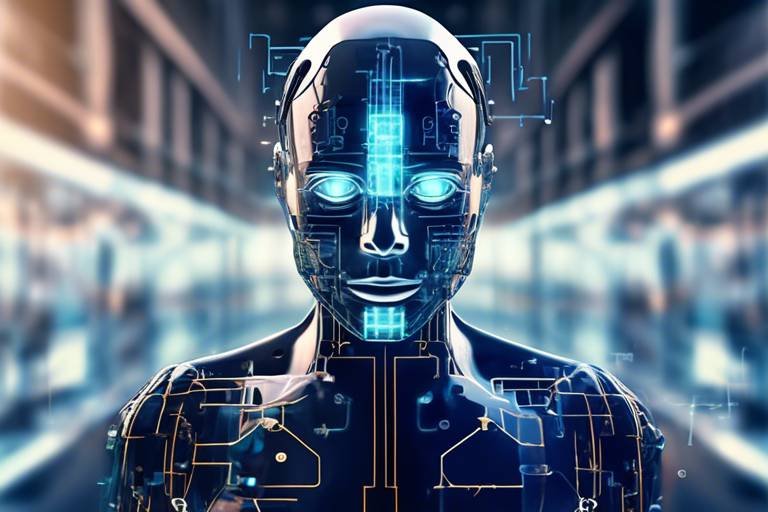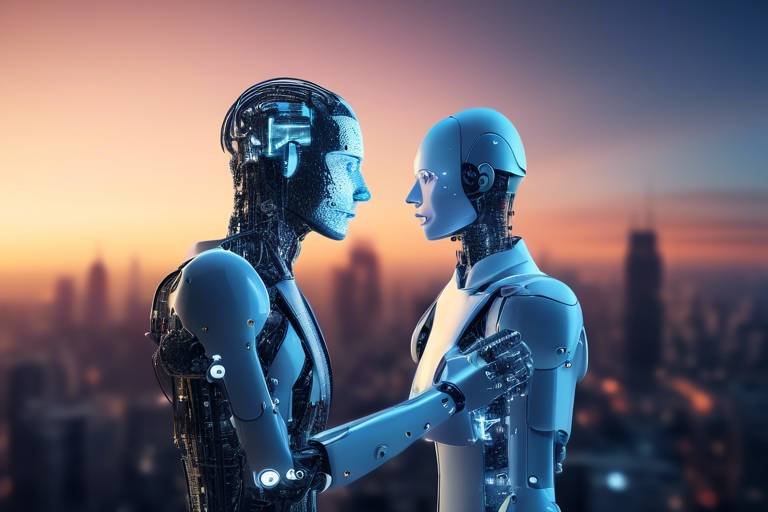Accelerating the Pace of Human Collaboration with AI Technology
In today's fast-paced world, the need for effective collaboration among teams has never been more critical. With the advent of AI technology, we are witnessing a remarkable transformation in how individuals and organizations collaborate. Imagine a workplace where communication flows effortlessly, tasks are automated, and insights are readily available at your fingertips. This is not a distant dream; it is the reality that AI is helping to create. By leveraging the power of artificial intelligence, teams can enhance their productivity, foster innovation, and tackle challenges with unprecedented efficiency. In this article, we will explore the various ways AI technology is elevating human collaboration, the benefits it brings, and what the future holds for teamwork and communication in an AI-driven landscape.
AI plays a crucial role in enhancing team collaboration by streamlining communication, automating tasks, and providing insights that help teams work more effectively together. Think of AI as a skilled assistant, tirelessly working behind the scenes to ensure that every team member is aligned and informed. From project management tools that prioritize tasks to communication platforms that integrate AI-driven chatbots, the tools available today are designed to facilitate seamless collaboration. Key AI tools that are making waves include:
- Project Management Software: Tools that use AI to help teams prioritize tasks based on urgency and importance.
- Virtual Assistants: AI-driven assistants that can schedule meetings, set reminders, and manage calendars.
- Collaboration Platforms: Software that integrates various communication channels, enabling real-time interaction among team members.
Communication is the backbone of any successful team, and AI-powered tools are revolutionizing how we interact. Imagine having a virtual assistant that can not only schedule your meetings but also remind you of the agenda and even provide insights on the participants. These tools, such as chatbots and virtual assistants, enhance clarity and efficiency in both remote and in-person settings. They ensure that everyone is on the same page, reducing the chances of miscommunication and misunderstandings.
One of the most exciting applications of AI in collaboration is real-time language translation. Picture this: a diverse team from different parts of the world working together on a project. Language barriers can be a significant hurdle, but AI-driven translation tools eliminate these obstacles. They enable seamless communication, allowing team members to interact as if they were speaking the same language. This capability not only enhances productivity but also fosters a sense of unity and inclusivity among team members.
By providing translation services, AI fosters inclusivity in teams with varied language backgrounds. This is particularly important in today's globalized world, where organizations often consist of employees from different cultures and linguistic backgrounds. AI tools can create a more equitable work environment by ensuring that everyone has a voice, regardless of their native language. This inclusivity is not just a nice-to-have; it is essential for driving innovation and creativity within teams.
To understand the impact of AI translation tools, let’s look at some real-world examples. Companies like Slack and Microsoft have successfully integrated AI-driven translation features into their platforms. These organizations have reported significant improvements in team collaboration and communication, leading to enhanced project outcomes. By examining these case studies, we can glean valuable insights into best practices and the tangible benefits of adopting AI technologies in collaborative settings.
In addition to enhancing communication, AI can automate routine tasks, freeing up team members to focus on more strategic initiatives. Imagine a world where mundane tasks like scheduling meetings, sending reminders, and tracking project updates are handled by AI. This not only saves time but also reduces the cognitive load on team members, allowing them to channel their energy into more creative and impactful work. The benefits of AI in task prioritization and delegation can lead to a more agile and responsive team dynamic.
AI enhances decision-making by providing data-driven insights and predictive analytics. In a collaborative environment, this means that teams can make informed decisions based on real-time data rather than relying on gut feelings or outdated information. With AI, collaborative decision-making is transformed into a more structured and efficient process, enabling teams to explore various options and select the best course of action.
AI tools can analyze vast amounts of data quickly, presenting it in user-friendly formats. This is crucial for collaborative decision-making, as visualized data helps teams grasp complex information at a glance. Imagine a dashboard that updates in real-time, showcasing key metrics and trends. This level of accessibility allows team members to engage in meaningful discussions, backed by solid data, leading to more effective outcomes.
AI enables teams to simulate various scenarios and model outcomes, aiding in strategic planning. This capability allows teams to explore "what-if" situations, helping them to anticipate challenges and devise effective solutions. By utilizing scenario modeling, teams can make proactive decisions, ensuring they are well-prepared for any eventuality. This level of foresight is invaluable in a world where change is constant and rapid.
As AI technology continues to evolve, its role in collaboration will expand. We can expect innovations that further enhance teamwork and communication, such as more sophisticated AI-driven tools that understand human emotions and adapt accordingly. Imagine AI that can gauge team morale and suggest interventions when needed. The future of collaboration is not just about efficiency; it’s about creating a more human-centric approach to teamwork.
- How does AI improve team collaboration?
AI improves team collaboration by streamlining communication, automating routine tasks, and providing data-driven insights. - Are AI-powered tools expensive?
The cost of AI tools varies, but many organizations find that the efficiency gains justify the investment. - Can AI replace human collaboration?
No, AI is designed to enhance human collaboration, not replace it. The human element remains essential for creativity and emotional intelligence.

The Role of AI in Team Collaboration
In today’s fast-paced work environment, the need for seamless collaboration among team members is more crucial than ever. Enter Artificial Intelligence (AI), the game-changer that is revolutionizing how teams communicate and work together. AI is not just a buzzword; it’s a powerful tool that enhances human collaboration by streamlining communication, automating mundane tasks, and providing valuable insights that can propel teams toward success. Imagine having a digital assistant that not only helps you manage your workload but also understands your team dynamics and suggests ways to improve them. Sounds amazing, right?
AI technologies are designed to facilitate collaboration in several impactful ways. For starters, they can automate repetitive tasks that often bog down productivity. Think about the time spent on scheduling meetings, sending reminders, or sorting through emails. With AI, these tasks can be handled automatically, allowing team members to focus on what truly matters: innovation and creativity. This is not just about saving time; it’s about enhancing the quality of work and the overall team experience.
Moreover, AI tools can analyze team performance data, providing insights that help identify strengths and areas for improvement. For instance, if a project is falling behind schedule, AI can pinpoint the bottlenecks and suggest solutions. This kind of data-driven decision-making empowers teams to make informed choices and fosters a culture of continuous improvement. Imagine a sports team where the coach uses data analytics to enhance the players’ performance—this is how AI operates in a collaborative setting.
Another significant aspect of AI in team collaboration is its ability to enhance communication. AI-powered communication tools, such as chatbots and virtual assistants, can provide real-time support, answering questions and facilitating discussions. These tools help ensure that information flows smoothly, even in remote work settings where miscommunication can easily occur. The result? Teams that are more aligned, engaged, and productive.
In summary, the role of AI in team collaboration is multifaceted and transformative. By automating tasks, providing actionable insights, and enhancing communication, AI not only makes teamwork more efficient but also more enjoyable. As we move forward, it’s clear that embracing AI technology will be essential for teams looking to thrive in an increasingly competitive landscape.
- How does AI improve team communication? AI improves communication by providing tools that facilitate real-time interactions, automate responses, and ensure that team members stay informed and engaged.
- Can AI really help in decision-making? Absolutely! AI analyzes data quickly and accurately, providing insights that help teams make informed decisions based on trends and predictive analytics.
- What are some examples of AI tools for collaboration? Examples include project management software with AI capabilities, chatbots for communication, and analytics tools that provide insights into team performance.

AI-Powered Communication Tools
In today's fast-paced work environment, effective communication is the backbone of any successful team. Enter . These innovative solutions are revolutionizing the way we interact, breaking down barriers and enhancing clarity. Imagine a world where your messages are not only sent instantly but also understood universally. That's exactly what AI is bringing to the table. By incorporating AI into communication, organizations can ensure that every team member, regardless of location or language, stays in sync.
One of the most exciting aspects of AI communication tools is their ability to automate routine interactions. Think about the time saved when a chatbot can handle frequently asked questions or schedule meetings without human intervention. This automation allows team members to focus on more meaningful tasks, fostering a culture of productivity and creativity. For instance, tools like Slack and Microsoft Teams have integrated AI features that suggest responses, summarize conversations, and even prioritize messages based on urgency.
Furthermore, AI tools can analyze communication patterns within teams. By examining how information flows and where bottlenecks occur, these tools can offer valuable insights. For example, if a particular team member consistently misses important updates, AI can recommend strategies to improve engagement. This level of analysis not only enhances the efficiency of communication but also contributes to a more cohesive team dynamic.
AI-powered tools are also making strides in language translation. With the rise of remote workforces, teams are often composed of individuals from diverse linguistic backgrounds. AI translation tools, such as Google Translate and Microsoft Translator, provide real-time translations, allowing team members to communicate effortlessly. This capability is a game-changer for global teams, as it eliminates the frustration of miscommunication and fosters a more inclusive environment.
Consider this: a project team consisting of members from different countries can collaborate on a document in their native languages, with AI ensuring that everyone understands the content. This not only enhances productivity but also encourages creativity, as diverse perspectives can be shared freely. The impact of these tools on team morale and inclusivity cannot be overstated.
To illustrate the effectiveness of these AI-powered communication tools, let’s take a look at a few notable examples:
| Tool | Key Features | Benefits |
|---|---|---|
| Slack | AI-driven message prioritization, automated reminders | Improved response times, reduced email overload |
| Microsoft Teams | Real-time translation, meeting transcription | Enhanced inclusivity, better meeting follow-ups |
| Zoom | AI-generated captions, virtual backgrounds | Accessibility for all participants, engaging presentations |
As we embrace these AI-powered communication tools, it’s important to remember that technology is only as effective as the people using it. Training and adapting to these tools will be crucial for teams to fully leverage their potential. The future of teamwork is bright, and with AI at the helm, we can expect even more innovative solutions to emerge.
In conclusion, AI-powered communication tools are not just a trend; they are reshaping the landscape of teamwork. By enhancing clarity, automating mundane tasks, and breaking down language barriers, these tools empower teams to collaborate more effectively than ever before. The question isn't whether to adopt these technologies, but rather how quickly can we integrate them into our daily workflows?
- What are AI-powered communication tools?
AI-powered communication tools are software solutions that utilize artificial intelligence to enhance communication, automate tasks, and provide insights for teams. - How do these tools improve team collaboration?
They streamline communication, reduce misunderstandings, and save time by automating routine tasks, allowing team members to focus on strategic initiatives. - Can AI translation tools really eliminate language barriers?
Yes, AI translation tools provide real-time translations, making it easier for diverse teams to communicate effectively without language hindrances.

Real-time Language Translation
In today's interconnected world, the ability to communicate across language barriers is more vital than ever. powered by AI technology is revolutionizing how teams collaborate globally. Imagine a diverse team composed of members from different countries, each speaking their native tongue. In the past, this could lead to misunderstandings or even a complete breakdown in communication. However, with AI-driven translation tools, these barriers are swiftly dismantled, allowing for seamless interaction.
These tools utilize advanced algorithms and machine learning to translate spoken or written language in real-time, making conversations fluid and natural. For instance, during a video conference, AI can instantly translate the dialogue, enabling participants to engage as if they were all speaking the same language. This not only enhances clarity but also fosters a sense of unity and collaboration among team members. The implications are profound:
- Increased Efficiency: Teams can communicate without delays caused by translation services, leading to faster decision-making.
- Greater Inclusivity: Employees who may not be fluent in the primary language used in meetings can participate fully, enhancing their sense of belonging.
- Broader Talent Pool: Companies can hire talent from around the world, knowing that language barriers will not hinder collaboration.
Moreover, AI-powered translation tools are not limited to spoken language. They can also translate documents, emails, and other written materials, ensuring that everyone is on the same page. Take, for example, a project report that needs to be shared with teams in multiple countries. Instead of relying on human translators who may take days, AI can provide immediate translations, allowing teams to access critical information without delay.
But what about the accuracy of these translations? While early AI translation tools often struggled with nuances and idiomatic expressions, advancements in natural language processing have significantly improved their performance. Today's AI systems can understand context, tone, and even cultural references, making translations more reliable than ever. This evolution means that teams can trust these tools to convey messages accurately, further enhancing collaboration.
In summary, real-time language translation powered by AI is a game-changer for global teamwork. By breaking down language barriers, these tools not only improve communication but also foster a more inclusive and efficient work environment. As we continue to embrace this technology, the potential for innovation and collaboration knows no bounds.
- How does AI handle different dialects? AI translation tools are continually learning from vast datasets, allowing them to adapt to various dialects and regional language nuances.
- Are AI translations always accurate? While AI translations are generally reliable, they may still struggle with complex phrases or cultural references. It's advisable to review critical translations.
- Can AI translation tools integrate with other collaboration platforms? Yes, many AI translation tools can be integrated with popular collaboration platforms, enhancing their functionality.

Enhancing Inclusivity in Teams
In today's globalized world, teams are often composed of individuals from diverse linguistic and cultural backgrounds. This diversity can be a tremendous asset, driving creativity and innovation. However, it can also pose challenges, particularly when it comes to communication. That's where AI steps in, acting as a bridge that connects team members across language barriers. Imagine a virtual translator that works tirelessly in the background, ensuring everyone is on the same page, regardless of their native tongue. This is not just a dream; it's a reality thanks to AI-powered translation tools.
AI technology enhances inclusivity in teams by offering real-time translation services that allow for seamless communication. For instance, consider a team meeting where participants speak different languages. With AI-driven translation tools, each member can communicate in their preferred language while the AI translates their words into the languages of others in real time. This not only fosters understanding but also encourages participation from all team members, making everyone feel valued and heard.
Moreover, these tools can help in creating an equitable work environment. By eliminating language barriers, AI ensures that all voices are represented, which is crucial for effective collaboration. Teams that leverage AI for translation can benefit from:
- Improved Communication: Clearer discussions lead to better decision-making.
- Increased Engagement: Team members are more likely to contribute when they can express themselves comfortably.
- Diverse Perspectives: A variety of viewpoints enriches problem-solving and innovation.
Real-world examples illustrate the benefits of AI in enhancing inclusivity. For instance, a multinational company implemented an AI translation tool during their global team meetings. The result? A significant increase in participation from team members who previously felt hesitant to share their ideas due to language barriers. This shift not only improved team morale but also led to innovative solutions that might have otherwise remained undiscovered.
In conclusion, AI technology is a powerful ally in fostering inclusivity within teams. By breaking down language barriers and promoting clear communication, AI ensures that every team member can contribute to their fullest potential. As organizations continue to embrace diverse teams, the role of AI in enhancing inclusivity will only become more critical, paving the way for a more collaborative and innovative future.
Q1: How does AI improve communication in diverse teams?
A1: AI improves communication by providing real-time translation services that allow team members to communicate in their preferred languages while ensuring everyone understands the conversation.
Q2: Can AI translation tools handle multiple languages simultaneously?
A2: Yes, many AI translation tools can handle multiple languages at once, making them ideal for multicultural team settings.
Q3: What are some examples of AI tools that enhance inclusivity?
A3: Tools like Google Translate, Microsoft Translator, and various AI-driven chatbots are excellent examples of technology that enhances inclusivity by breaking down language barriers.
Q4: How does inclusivity impact team performance?
A4: Inclusivity leads to improved communication, increased engagement, and the incorporation of diverse perspectives, all of which contribute to better team performance and innovation.

Case Studies of Successful Implementation
When it comes to the integration of AI in enhancing collaboration, there are numerous success stories that illustrate its transformative power. Companies across various sectors have embraced AI technologies to streamline their operations and improve teamwork. Let's dive into a few notable case studies that showcase how organizations have successfully implemented AI tools to foster collaboration and innovation.
One standout example is Salesforce, a leading customer relationship management platform. They integrated AI with their Einstein Analytics tool, which provides teams with actionable insights drawn from vast amounts of customer data. By automating data analysis, teams can focus more on strategy and less on sifting through information. This shift not only enhances productivity but also encourages a more collaborative environment where team members can share insights and make informed decisions together.
Another compelling case is that of Unilever, a global consumer goods company that has leveraged AI for internal communication and project management. By employing AI-powered chatbots, Unilever has improved communication flow among its teams, especially in remote settings. These chatbots help answer common questions, provide updates, and facilitate quick decision-making. As a result, team members can collaborate more effectively, regardless of their geographical locations.
Furthermore, Microsoft has made significant strides with its AI-enhanced tools like Microsoft Teams. By incorporating features such as real-time language translation and automated meeting summaries, Microsoft has created an inclusive platform that caters to diverse teams. This has proven particularly beneficial for multinational teams, as it enables seamless collaboration without the hindrance of language barriers. The ability to communicate effortlessly fosters a sense of unity and shared purpose among team members.
To illustrate the impact of these implementations, we can summarize the key outcomes in the table below:
| Company | AI Tool | Outcome |
|---|---|---|
| Salesforce | Einstein Analytics | Increased productivity through automated data insights |
| Unilever | AI Chatbots | Enhanced communication flow and quicker decision-making |
| Microsoft | Microsoft Teams | Improved inclusivity and collaboration across diverse teams |
These case studies not only highlight the successful implementation of AI tools but also demonstrate the tangible benefits that arise from fostering a collaborative environment. By embracing AI, companies can enhance their operational efficiency, encourage teamwork, and ultimately drive innovation. As we look to the future, it’s clear that the role of AI in collaboration will only continue to grow, paving the way for even more remarkable advancements.
- What is the primary benefit of using AI in team collaboration? AI enhances communication, automates routine tasks, and provides valuable insights, allowing teams to work more effectively together.
- Can AI tools be used in both remote and in-person settings? Yes, AI communication tools are designed to improve interactions regardless of the work environment, making them versatile for any team.
- How does AI foster inclusivity in diverse teams? By offering real-time language translation and other supportive features, AI enables team members from different backgrounds to communicate seamlessly.
- What are some examples of AI tools used for task management? Tools like Asana and Trello have integrated AI capabilities to help prioritize tasks and streamline project management.

Automated Task Management
In today's fast-paced work environment, the need for efficiency is more critical than ever. is revolutionizing how teams operate, allowing them to focus on what truly matters—innovation and strategic thinking. Imagine a world where mundane tasks, like scheduling meetings or tracking project deadlines, are taken care of by intelligent systems. Sounds like a dream, right? Well, with AI, this dream is becoming a reality.
AI tools can automatically prioritize tasks based on urgency and importance, ensuring that team members are always working on the right things at the right time. For instance, an AI-driven project management tool can analyze the workload of each member and suggest optimal task assignments. This not only increases productivity but also enhances team morale, as members feel empowered to contribute to meaningful projects rather than getting bogged down by repetitive tasks.
Consider a scenario where a marketing team is launching a new campaign. With AI, the tool can:
- Analyze past campaign data to determine the most effective strategies.
- Automate the scheduling of social media posts and email blasts.
- Send reminders to team members about upcoming deadlines.
Moreover, AI can provide real-time updates on project statuses, keeping everyone in the loop. Imagine having a digital assistant that not only reminds you of your tasks but also alerts you when a project is falling behind schedule. This proactive approach to task management can significantly reduce the chances of missed deadlines and enhance overall team performance.
In conclusion, automated task management powered by AI is not just a luxury; it's becoming a necessity in the modern workplace. By streamlining operations and freeing up valuable time, AI empowers teams to focus on their core objectives—driving innovation and achieving success. As we embrace these technologies, we can look forward to a future where collaboration is not only easier but also more effective, leading to remarkable outcomes.

AI and Decision-Making Processes
In today's fast-paced world, making decisions can often feel like trying to navigate a maze blindfolded. The sheer volume of data available can overwhelm even the most seasoned professionals. This is where AI technology steps in as a game-changer, transforming the way teams approach decision-making processes. By leveraging data-driven insights and predictive analytics, AI enables teams to make informed decisions quickly and efficiently. Imagine having a trusted advisor that can sift through mountains of information and present only the most relevant insights; that's the power of AI.
AI enhances collaborative decision-making by providing teams with the tools they need to analyze data effectively. For instance, AI algorithms can identify patterns and trends that may not be immediately obvious to human analysts. This capability allows teams to focus on strategic discussions rather than getting bogged down in data crunching. As a result, meetings become more productive, and decisions are made faster. It's like having a supercharged brainstorming session where every idea is backed by solid evidence.
Moreover, AI tools can facilitate scenario simulation and modeling, allowing teams to visualize potential outcomes based on different variables. This means that before making a significant decision, teams can explore various scenarios, assessing risks and rewards in a virtual environment. For example, a marketing team can use AI to simulate the impact of a new campaign based on historical data, predicting customer responses and optimizing their strategy accordingly. This level of foresight can be invaluable in today's competitive landscape.
To illustrate the impact of AI on decision-making, consider the following table that highlights key benefits:
| Benefit | Description |
|---|---|
| Speed | AI processes data at lightning speed, enabling rapid decision-making. |
| Accuracy | Data-driven insights reduce the likelihood of human error. |
| Scalability | AI can analyze large datasets, making it suitable for teams of any size. |
| Predictive Analytics | AI forecasts future trends, helping teams to make proactive decisions. |
Ultimately, the integration of AI in decision-making processes not only enhances the quality of decisions but also fosters a culture of collaboration within teams. By empowering team members with the right tools and insights, organizations can cultivate an environment where everyone feels valued and heard. It's like turning a group of individuals into a well-oiled machine, where each part works in harmony to achieve a common goal.
As we look to the future, the potential of AI in decision-making is only set to grow. With advancements in machine learning and natural language processing, we can expect even more sophisticated tools that will further streamline collaboration and enhance team dynamics. The question is not whether AI will play a role in decision-making, but rather how organizations will harness its capabilities to drive success.
- How does AI improve decision-making? AI improves decision-making by providing data-driven insights, identifying patterns, and simulating potential outcomes, thus enabling faster and more accurate decisions.
- What are some examples of AI tools used in decision-making? Examples include predictive analytics software, data visualization tools, and scenario modeling platforms that help teams assess various options.
- Can AI completely replace human decision-making? While AI can enhance decision-making, it is not a replacement for human judgment. The best outcomes often arise from a combination of AI insights and human expertise.

Data Analysis and Visualization
In today's fast-paced world, the ability to analyze and visualize data is more crucial than ever. AI tools have revolutionized how teams approach data analysis, transforming raw numbers into actionable insights. Imagine trying to find a needle in a haystack; without the right tools, it seems nearly impossible. However, with AI, that needle becomes much easier to spot, allowing teams to focus on what truly matters. AI algorithms can sift through massive datasets in mere seconds, identifying trends and patterns that would take humans hours, if not days, to uncover.
One of the most significant advantages of using AI for data analysis is its capacity for data visualization. Visual representation of data helps teams grasp complex information quickly and intuitively. Instead of drowning in spreadsheets, teams can use dynamic charts, graphs, and dashboards that bring data to life. This visual approach not only enhances understanding but also fosters better communication among team members. After all, a picture is worth a thousand words, right?
To illustrate this point, consider the following table that highlights the differences between traditional data analysis methods and AI-enhanced techniques:
| Aspect | Traditional Methods | AI-Enhanced Methods |
|---|---|---|
| Speed | Slow, often requiring manual input | Rapid, processing vast amounts of data instantly |
| Accuracy | Prone to human error | Highly accurate, utilizing advanced algorithms |
| Insights | Limited to basic trends | In-depth analysis with predictive capabilities |
| Collaboration | Challenging to share findings | Easy visualization encourages team discussions |
Moreover, AI tools not only analyze historical data but also provide predictive analytics, enabling teams to anticipate future trends. This capability is like having a crystal ball that helps teams make informed decisions. For instance, by analyzing customer behavior patterns, businesses can tailor their strategies to meet future demands, ultimately gaining a competitive edge.
In collaborative settings, the ability to visualize data can significantly enhance discussions and brainstorming sessions. Instead of debating over numbers, teams can engage in more meaningful conversations about what the data actually means. This shift from numbers to narratives brings a new level of understanding and collaboration, fostering an environment where innovative ideas can thrive.
In conclusion, the integration of AI in data analysis and visualization has transformed the way teams work. By turning complex data into clear, actionable insights, AI empowers teams to make better decisions, collaborate more effectively, and ultimately drive innovation. So, the next time you find yourself faced with a mountain of data, remember that AI is here to help you navigate through it with ease.
- What is the role of AI in data analysis?
AI enhances data analysis by automating the process, providing faster and more accurate insights, and enabling predictive analytics. - How does data visualization improve teamwork?
Data visualization helps team members understand complex information quickly, facilitating better communication and collaboration. - Can AI tools be used for real-time data analysis?
Yes, many AI tools are capable of analyzing data in real-time, allowing teams to make immediate decisions based on the latest information.

Scenario Simulation and Modeling
In today's fast-paced business environment, the ability to anticipate future challenges and opportunities is crucial. This is where come into play, powered by the incredible capabilities of AI technology. Imagine being able to run multiple simulations of potential business scenarios before making a decision—how invaluable would that be? AI allows teams to create detailed models that predict outcomes based on various inputs, helping to visualize the potential impacts of different strategies.
With AI-driven tools, teams can explore a variety of scenarios, such as market changes, resource allocation, or even shifts in consumer behavior. For instance, if a company is considering launching a new product, AI can simulate how different pricing strategies might affect sales in diverse markets. This not only saves time but also minimizes risks associated with decision-making. By analyzing data from past behaviors and current trends, AI can offer predictions that are both insightful and actionable.
Furthermore, the collaborative aspect of scenario simulation is enhanced through AI. Team members can engage in real-time discussions about the simulations, adjusting variables and immediately seeing the results. This level of interactivity fosters a deeper understanding of the data and encourages innovative thinking. Imagine a team gathered around a digital dashboard, tweaking parameters and instantly visualizing the outcomes—it's like having a crystal ball for business strategy!
To illustrate the effectiveness of scenario simulation, consider the following table that outlines the key advantages of using AI in this context:
| Advantage | Description |
|---|---|
| Risk Mitigation | By exploring various scenarios, teams can identify potential pitfalls and develop contingency plans. |
| Data-Driven Insights | AI analyzes vast amounts of data to provide evidence-based recommendations. |
| Enhanced Collaboration | Real-time simulations promote teamwork and collective problem-solving. |
| Time Efficiency | Quickly assess multiple scenarios without the need for extensive manual analysis. |
In summary, scenario simulation and modeling powered by AI not only enhance decision-making processes but also promote a culture of collaboration and innovation within teams. As organizations continue to embrace these technologies, the ability to predict and prepare for future challenges will only become more refined, leading to better outcomes and sustained success.
- What is scenario simulation? Scenario simulation involves creating models to predict outcomes based on various inputs, allowing teams to visualize the potential impacts of different strategies.
- How does AI enhance scenario modeling? AI analyzes large datasets and provides insights that help teams understand the implications of different scenarios, making decision-making more data-driven.
- Can scenario simulation be used in any industry? Yes, scenario simulation can be applied across various industries including finance, healthcare, marketing, and more, to improve strategic planning and risk management.
- What tools are commonly used for scenario simulation? Several AI-powered tools and platforms are available, such as Microsoft Azure Machine Learning, IBM Watson, and various bespoke solutions tailored to specific business needs.

Future Trends in AI Collaboration
The landscape of AI collaboration is evolving at a breakneck speed, and it's fascinating to consider what the future holds. As organizations increasingly adopt AI technologies, we can expect a surge in innovative applications that will redefine how teams work together. Imagine a world where AI not only assists but actively enhances human creativity and decision-making. This isn't just a distant dream; it's on the horizon.
One of the most exciting trends is the rise of augmented collaboration platforms. These platforms will leverage AI to create immersive environments where teams can interact in real-time, regardless of their physical locations. Picture virtual meeting rooms that use AI to analyze participant engagement, suggest agenda items based on past discussions, and even provide real-time feedback on the effectiveness of the meeting. This kind of technology could revolutionize how we perceive remote work, making it feel more personal and connected.
Another trend to watch is the integration of machine learning algorithms into project management tools. These algorithms can analyze team performance and project outcomes, providing valuable insights that help leaders make informed decisions. For instance, AI can predict potential bottlenecks in a project timeline based on historical data, allowing teams to pivot and address issues before they escalate. This proactive approach not only saves time but also enhances overall productivity.
Moreover, as AI continues to evolve, we can anticipate improvements in personalized AI assistants that cater to individual team members. These assistants will learn from user behavior and preferences, offering tailored suggestions for task management, scheduling, and even conflict resolution. Imagine having an AI buddy that knows your work style and can recommend the best times for collaboration or alert you to potential misunderstandings with colleagues. This level of personalization could significantly enhance team dynamics and foster a more collaborative culture.
Furthermore, as organizations become more global, the need for AI-driven cultural intelligence tools will grow. These tools can help teams navigate cultural differences and improve communication among diverse groups. By analyzing language nuances, cultural references, and social cues, AI can provide insights that promote understanding and inclusivity. This will not only enhance collaboration but also contribute to a more harmonious workplace.
Lastly, the future of AI collaboration will likely see an increased emphasis on ethical considerations. As AI becomes more integrated into our daily workflows, discussions around data privacy, bias in algorithms, and the impact of automation on jobs will become paramount. Companies will need to establish guidelines and frameworks to ensure that AI is used responsibly and ethically, fostering trust among team members and stakeholders.
In conclusion, the future of AI collaboration is bright and full of potential. From augmented collaboration platforms to personalized AI assistants, the possibilities are endless. As we embrace these advancements, it’s crucial to remain vigilant about the ethical implications and strive for a balance that enhances human capabilities without compromising our values.
- What is augmented collaboration? Augmented collaboration refers to the use of advanced technologies, including AI, to enhance teamwork and communication, often through immersive environments.
- How can AI improve project management? AI can analyze data to predict project outcomes, identify bottlenecks, and provide insights that help teams make informed decisions.
- What are cultural intelligence tools? These are AI-driven tools designed to help teams navigate cultural differences, improving communication and understanding among diverse groups.
- Why is ethical consideration important in AI collaboration? Ethical considerations are crucial to ensure that AI is used responsibly, protecting data privacy and minimizing bias, thus fostering trust within teams.
Frequently Asked Questions
-
How does AI enhance team collaboration?
AI enhances team collaboration by streamlining communication, automating routine tasks, and providing valuable insights. With tools like chatbots and virtual assistants, teams can communicate more effectively, allowing for smoother workflows and reduced misunderstandings. Imagine having a virtual teammate that never sleeps, always ready to assist with information and task management!
-
What are some examples of AI-powered communication tools?
Some popular AI-powered communication tools include chatbots, virtual assistants like Siri or Google Assistant, and AI-driven platforms like Slack and Microsoft Teams. These tools help in organizing conversations, scheduling meetings, and even translating languages in real-time, making collaboration a breeze!
-
How does real-time language translation work in AI?
Real-time language translation works by using advanced algorithms to convert spoken or written language into another language almost instantly. This means that team members from different linguistic backgrounds can communicate without barriers, fostering a more inclusive and diverse work environment.
-
Can AI tools improve inclusivity in teams?
Absolutely! AI tools can significantly improve inclusivity by providing translation services, enabling team members from various language backgrounds to collaborate seamlessly. This creates a more equitable work environment where everyone feels valued and understood, breaking down cultural barriers.
-
What are the benefits of automated task management?
Automated task management allows teams to focus on strategic initiatives by handling routine tasks automatically. This not only saves time but also ensures that tasks are prioritized and delegated efficiently. Think of it as having a personal assistant that organizes your to-do list, so you can concentrate on what really matters!
-
How does AI support decision-making processes?
AI supports decision-making by providing data-driven insights and predictive analytics. By analyzing vast amounts of data quickly, AI tools can present information in user-friendly formats, enabling teams to make informed decisions based on real-time data. It's like having a crystal ball that helps you see potential outcomes before making a choice!
-
What future trends can we expect in AI collaboration?
As AI technology evolves, we can expect trends like enhanced personalization in collaboration tools, more advanced predictive analytics, and even greater integration of AI in remote work environments. These innovations will likely make teamwork even more efficient, allowing teams to collaborate across distances as if they were in the same room!


